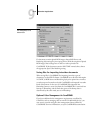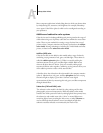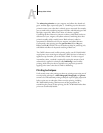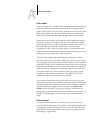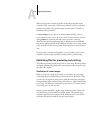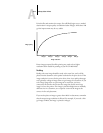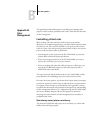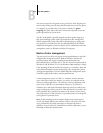
A
A-8 Desktop Color Primer
Color text can add flair to documents printed on paper when used skillfully.
This technique is widely used in presentations. When using color text, avoid
dazzling text and background combinations created from primary
complements, especially red and cyan or red and blue; they are visually
fatiguing and hard to read. Color text is more legible when distinguished
from its background by a difference in lightness—for example, dark blue text
on a light beige background. In addition, using many different colors in a
string of text makes for a confused appearance and is hard to read. However,
using a single highlight color is an effective way to draw the reader’s eye to
selected words. See plate 10 for color text samples.
When using color text, keep in mind that small font sizes typically do not
print in color with the same sharpness as in black. In most applications, black
text prints exclusively in black toner, while color text usually prints with two
or more toners. Any misregistration between the different toners on paper
causes color text to lose definition. You can make test prints to find the
smallest point size at which color text prints clearly. When using high-end
graphics applications that allow you to specify color as percentages of cyan,
magenta, yellow, and black, you can create pure cyan or pure magenta text
that prints with the same sharpness as black text. (Pure yellow text is
extremely hard to read on anything but a dark or complementary
background.)
Raster images and vector images
Two broad categories of artwork can be printed from a personal computer to
a color printer: raster and vector images (plate 11).
A raster image, also referred to as a bitmap, is composed of a grid of pixels,
each assigned a particular color value. The grid, when sufficiently enlarged,
resembles a mosaic made from square tiles. Examples of raster images include
scans and images created in painting or pixel-editing applications, such as
Photoshop and Painter.
The amount of data found in a raster image depends on its resolution and
bit depth. The resolution of a raster describes the compactness of the pixels
and is specified in pixels per inch (ppi). The bit depth is the number of bits of
information assigned to each pixel. Black and white raster images require only
one bit of information per pixel. Grayscale images require 8 bits per pixel. For
photographic quality color, 24 bits of RGB color information are required
per pixel, yielding 256 levels of red, green, and blue. For CMYK images, 32
bits per pixel are required.



